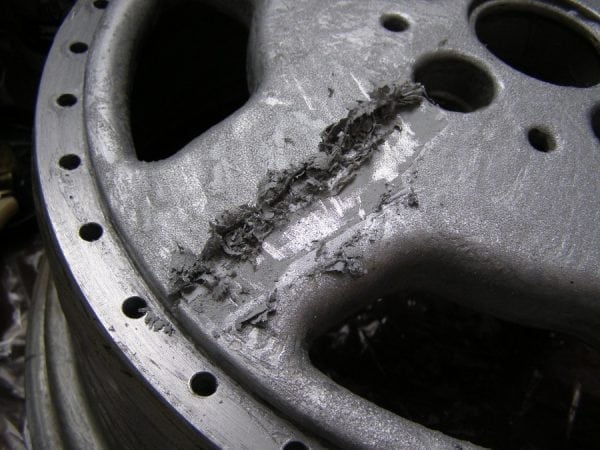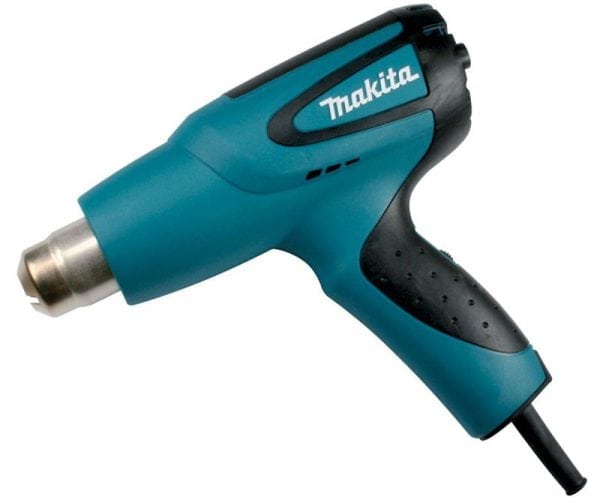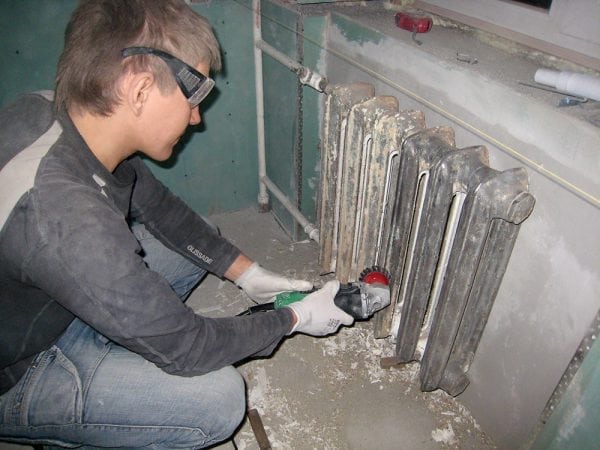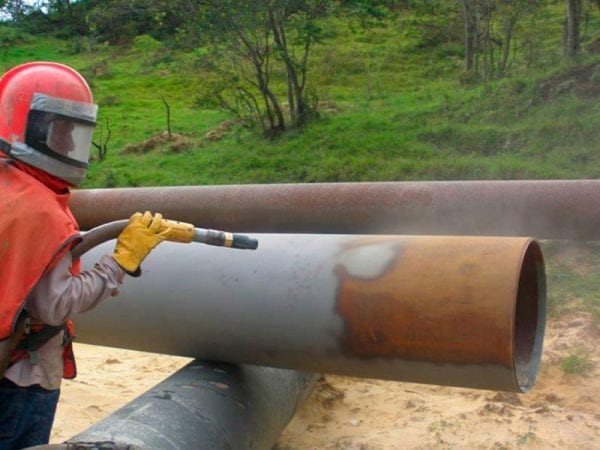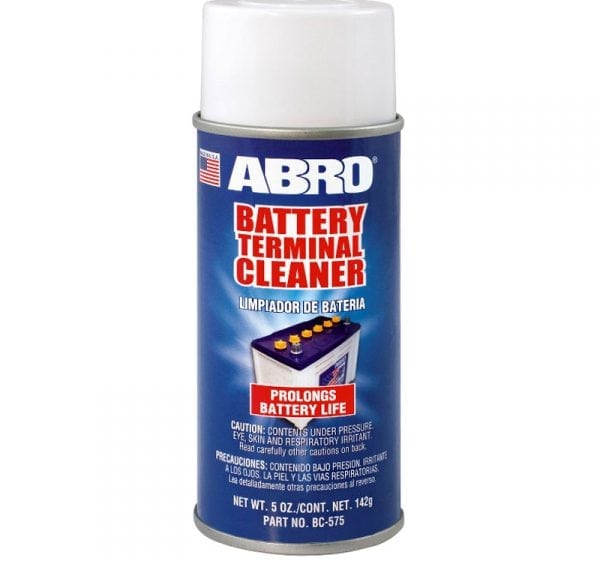Before carrying out repairs, the question often arises: should I remove the old paint layer? The answer to this question largely depends on future actions. For example, if you plan to close the metal with plasterboard panels, there is no need to remove the paint layer. However, if the surface needs to be painted, tile laying or plastering is planned, then the removal of old paint cannot be avoided. How to remove paint from metal will be discussed below.
- Method selection
- Paint Removal Methods
- Mechanical restoration
- Sandblasting and shot blasting methods
- Chemical treatment
- Heat treatment
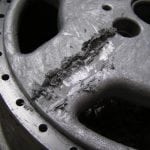
Method selection
The method for removing paint depends on the following circumstances:
- type of material and surface properties;
- varieties of paint composition;
- number of layers;
- adhesive characteristics of paint and metal;
- working tools;
- budget amount.
The most common types of paints include:
- water emulsion;
- acrylic;
- oil (they are most difficult to remove).
If the type of paint is unknown, you will have to act empirically.
Before removing old paint from metal, it is necessary to prepare the necessary materials and tools, including:
- metal scraper, chisel or putty knife;
- brush or roller;
- water;
- electric drill with a nozzle corresponding to the task;
- building hair dryer;
- angle grinder (grinder);
- safety glasses, gloves, and when working with chemicals - a respirator.
Paint Removal Methods
There are several options for removing old paintwork:
- mechanical;
- thermal;
- chemical.
Below we dwell in more detail on each of the methods.
Mechanical restoration
Mechanical exposure is one of the most popular and affordable methods of cleaning metal from old paint. The advantage of the technique lies in its availability, low cost and high enough efficiency. The disadvantage is the high complexity and considerable time.
Due to the high labor costs, the machining of painted surfaces is carried out mainly with small amounts of work, in hard-to-reach areas. Also, mechanical methods of exposure are used when it is necessary to ensure high-quality cleaning under conditions of inadmissibility even of small damage to the material (for example, during restoration work). In addition, manual cleaning is used in situations where it is not necessary to completely remove the paint layer, but only need to remove the peeling parts of the coating.
The undoubted advantage of mechanical cleaning is its versatility. So you can remove even the most resistant paint, for example, heat-sprayed enamel, nitro-paint, resin-based coatings, etc.
A wide range of tools can be used for work, including spatulas, blades, sandpaper with varying degrees of granularity, files, rasps, grinding nets and other abrasive devices.
Instructions for mechanical cleaning:
- We remove the upper paint layer with an iron brush, knife or spatula. Then use the sandpaper. If the surface area allows, the emery paper can be pulled onto a wooden beam and the surface can be treated with this tool. When working with emery, it is recommended to pay attention to the grain size of the abrasive.For example, if surface treatment was started with sandpaper with P80 grains, then you need to complete the process with sandpaper with grit from P320 to P420. The grain index is indicated by the manufacturer on the back of the sandpaper. The process ends with the application of an anti-corrosion spray.
- On large areas and relatively flat surfaces, a wet cleaning technique is used. The essence of the method consists in abundant wetting of the metal with water and further processing of the material with waterproof sandpaper.
- In the presence of an electric drill or grinder, as well as a flat surface, you can use the so-called cord brush. This device is a conventional metal brush, adapted for fixing on these power tools. Cord brushes come in different sizes and degrees of hardness. Working with electric tools saves time and effort, but hard-to-reach areas cannot be cleaned in this way.
- Also, strippers and surface grinders are sometimes used to remove paint. Milling cutters are especially useful when cleaning plaster, concrete and other similar surfaces from paint, but are completely unsuitable for working with metal. A feature of surface grinding machines is the inefficiency in the processing of oil coatings, since in this case the sandpaper wears out quickly due to the abundance of paint. Moreover, to perform high-quality cleaning of small surface areas, surface grinders are indispensable. In addition, this type of device copes with water emulsion substances.
to contents ↑
Sandblasting and shot blasting methods
The most effective way of machining the surface is to use sandblasting or shot blasting equipment. It does not matter the material or shape of the part.
To remove paint, a powerful air or water jet is used, which directs quartz sand, shot or some other abrasive material to the surface to be treated. As a result, crushing and peeling of not only the paintwork, but also rust, as well as any other types of persistent contamination, occurs.
When working with inkjet equipment, an important circumstance should be taken into account: the thickness of the metal part should not be less than 2-3 centimeters, since otherwise visible deformations of the material will occur.
The main disadvantage of the sandblasting technique is the high cost of equipment, usually inaccessible to residential users. Also, special training is needed for the personnel serving the apparatus and the skills of the work itself in sandblasting the paint particles.
It should also be noted that the sandblasting method is not suitable for too fragile parts. A powerful jet indiscriminately removes not only paint or traces of corrosion, but also any other not too strong elements, and therefore damage to the structure is possible.
Despite these shortcomings, sandblasting and shot blasting are considered the most effective ways to remove old paint. Moreover, in some cases, such methods are indispensable, for example, when it is necessary to remove paint from heating radiators.
to contents ↑Chemical treatment
Another way to remove the paintwork from the metal is the so-called wash, which is a chemically active substance. In fact, the wash does not wash off, but decomposes the coloring matter. As a result, the paint swells and can be removed with a conventional spatula. Rinses are made in the form of gels, powders, ointments and aerosols.
Note! Unlike abrasives, washes can be used for metal parts of any configuration, regardless of the complexity of the relief.
Flushing is applied as follows:
- Apply a gel or other type of flushing agent to the metal surface. To do this, use a brush.
- Give the wash well to soak the coating for 20-30 minutes. In the end, the enamel layer will swell, the coating will crack. After that, we take a spatula and remove the remnants of the coloring matter.
- Aerosol washes act much faster - after 1-2 minutes the result will be visible.
- After the pieces of paint have been removed from the surface, the metal should be washed with soapy water and then treated with anti-corrosion primer.
Among the most famous washing brands can be noted such as "Prestige", "Body", "ABRO", "646". However, even the best washings are not very effective against old coatings, which are more than 2-3 years old. Typically, chemicals only slightly soften old paint.
A serious drawback of chemicals is their high toxicity, therefore, when working with them, special attention should be paid to safety measures. Before starting work, wear protective glasses, gloves and a respirator.
When choosing a flushing preparation, it is recommended to ask the seller about the characteristics of the product. In particular, you should learn about the compatibility of the chemical with metal and one or another type of paint material.
to contents ↑Note! If it is not possible to determine the type of paint with which the metal is coated, a universal wash can be used. However, universal formulations are less effective in comparison with specialized ones.
Heat treatment
Paint can also be removed by burning. To do this, you need a blowtorch or an oxygen-acetylene torch. This is the most radical way, guaranteeing the cleaning of a metal surface of any shape from foreign materials. As in the case with the chemical technique, burning involves combining with mechanical influences when the process completes the cleaning of the material with a spatula.
Despite the effectiveness of the method, its obvious disadvantages should be noted:
- Not every metal can be subjected to intense heating. For example, cast iron products simply go cracked, and sheet metal is deformed. After heating, many types of metal will become more fragile due to a reduction in the carbon component.
- Scale may form on the metal.
- The technique relates to fire hazard.
- When the metal is heated, toxic substances are released into the environment.
Thermal cleaning of material from paint is carried out as follows:
- We take the heating device in the left hand.
- We direct the flame or hot air to the metal. We warm up the metal until the paint melts, then move on.
- We remove the remnants of the paintwork with a spatula.
All three methods described above have their advantages and disadvantages, so the final choice depends on many circumstances. When choosing a cleaning method, a number of circumstances should be taken into account, including the type of paintwork, grade and thickness of the metal, as well as its size and shape.

